The interaction between salt and sediment changes the geopressure relationships below salt, increasing drilling risk.
Selim Shaker, Geopressure Analysis Services, Inc.
The high rewards of finding hydrocarbon in subsalt plays make them very attractive for exploration. However, it is a challenging mission. Subsurface pressure uncertainty causes recurrent failure to reach the drilling targets.
After the discovery of Mahogany Field in the GOM 15 years ago, special attention was directed to subsalt plays. That attention gradually shifted from the shelf to deep water (>1000-ft water depth), Fig. 1. Deepwater yearly production increased from 21 million bbl of oil and 33 Bcfg in 1985 to 339 million bbl of oil and 1.1 Tcfg in 2006, according to the US Minerals Management Service. Consequently, the cost of acquiring and testing prospects has increased due to the prospects’ location in deepwater salt mini-basins. The prospect’s risk results from intricate geopressure compartmentalization in a salt environment accompanied by a deep mud line, deep target depth and shallow sediment hazards.
|

|
|
Fig. 1. Deepwater GOM prospect risk results from intricate geopressure compartmentalization in a salt environment.
|
|
In the GOM’s Tertiary-Quaternary, geopressured sediments are caused by compaction disequilibrium. Lithology and maximum principal stress control this process. Salt’s unique petrophysical properties contribute to substantial changes in pore pressure gradients in the host sediments above and below the salt layer. Salt’s low density retards the overburden gradient below the salt, and enhances it above the salt. Its negligible permeability creates a perfect seal. Moreover, salt’s ductile nature generates a variety of structural styles that affect stress orientation and magnitude. Subsurface geopressure dictates sealing and retention capacities, and therefore affects oil- and gas-trapping capability in a specific structural closure. This article addresses salt-related risk assessment from a geopressure standpoint.
CONCEPTS DEFINITIONS
In extensional salt basins, the magnitude and direction of the principal stresses are controlled by sediment load, salt thickness and salt emplacement/displacement history. Therefore, the maximum Principal Stress (PS) is not necessarily represented by the vertical weight of the overburden. Salt buoyancy usually acts upward and has a tendency to accelerate and decelerate PS above and below the salt, respectively.
In several subsalt wells drilled in the mini-basins of the Mississippi Canyon, Green Canyon and Garden Banks areas (MC 211, 292, 619, 627, 674 and 714; GC 153 and 699; and GB 217), a distinctive shift of the Pore Pressure (PP) envelopes and normal compaction trends takes place across the salt body. A lower PP gradient has been observed below the salt and a higher gradient above the salt barrier. On a salt-rooted mini-basin scale, a higher gradient was also observed in areas where the salt was emplaced and a lower gradient where the salt withdrew.1
On the other hand, in a compressional system, the lateral stress generated by salt movement acts as the maximum PS, whereas overburden sediment load represents the minimum stress, i.e. Fracture Pressure (FP).
At the Sigsbee Escarpment, the salt mass’s toe is creeping down-dip near the mud line, creating thrust folds and faults out of the older underlying sediments. This has produced a potential new deepwater frontier, Fig. 2. Several Wilcox-equivalent (Lower Tertiary) discoveries have been announced recently in the Perdido Foldbelt and Walker Ridge.2 Chevron’s large discovery in Block WR 758, Jack No. 2, is along this trend. The well cost Chevron about $100 million and took three months to drill, according to a press release.
|
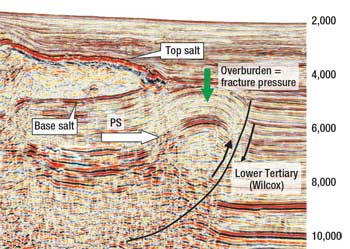
|
|
Fig. 2. The Sigsbee Escarpment salt mass’s thrust folds and faults have produced a potential new deepwater frontier. Modified after Chowdhury and Lopez-Mora 2004.
|
|
Stress fields, in particular the maximum PS and FP, determine the pressure envelopes in the subsurface sedimentary column. PS dictates the progress (transgression and regression) of the PP, and FP represents the breaching limit, Fig. 3.
|
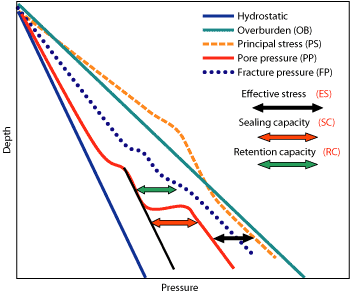
|
|
Fig. 3. Stress fields determine pressure envelopes in the sedimentary column.
|
|
Terzaghi3 established the relationship between the PS and PP as:
PP = PS - ES (effective stress)
Therefore, PS is the driving mechanism of PP buildup. Sealing capacity is expressed by the transgression of the excess pressure in a specific compartment, whereas retention capacity represents the maximum capability of trapping a specific hydrocarbon column in a structural closure.4 The difference between FP and PP plays an essential role in dictating the retention capacity.
MODELS AND CASE HISTORY
The dynamic and emplacement history of allochthonous salt bodies is a complex issue to evaluate in this short article. Therefore, density difference between the salt and host sediments will be considered the main driving mechanism for PP development. The sediment above salt is subjected to a PS greater than the overburden stress as a result of salt buoyancy and consequently has a higher PP gradient.
This leads to a large reduction of the drilling tolerance window (FP to PP). These conditions require higher mud weight and multiple casing points to drill this upper section.
On the other hand, the PS on the rock column below the salt is reduced due to salt buoyancy effect. This leads to a higher retention capacity and the possibility of a thicker hydrocarbon section being trapped below salt. This also might reduce the sealing capacity (weaker seals) below the salt. The conceptual model in Fig. 4 exhibits this relationship. Moreover, it clearly shows the substantial drop of the PP and FP below the salt due to PS reduction. This leads to widespread, known drilling problems at the salt-sediment interface.
|
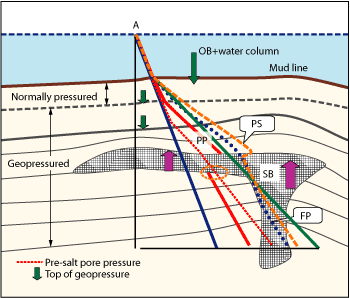
|
|
Fig. 4. This conceptual geopressure model shows how the principal stress below the salt is reduced by salt’s buoyancy effect.
|
|
Crosby Field. This field was an exploration success and presently produces from a subsalt trap. It covers four blocks (Mississippi Canyon Blocks 898, 899, 941 and 942). MC 899 production peaked at 14.4 million bbl of oil and 19.1 Bcfg in 2002. In this block, Well No. 6 represents a key example of multiple pay zones below and above the salt. A thick gross oil and gas pay zone was trapped due to the large retention capacity, resulting from the subsalt PP regression. The measured PP at the ~18,000-ft pay zone was about 12,000 psi (pressure gradient of 0.66 psi/ft). The lower Pressure Gradient (PG) may be responsible for the relatively rapid production decline of this block. The well’s reported production in 2006 was 2.18 million bbl of oil and 3.16 Bcfg. High PS/PG in the suprasalt resulted in several kicks and water flow incidents and, therefore, seven casing points were needed to drill above the salt. Conversely, in the subsalt section, two casing strings from the base of the salt to TD (18,250-ft TVD) were set.
Several sidetracks were performed to reach the lower objectives below the salt due to several losses of circulation (low PS and low PG). Eventually, production will resume from the suprasalt pay zones.
Mackerel prospect. Wildcat Well 1 in Mississippi Canyon 619 was a disappointing subsalt exploration endeavor. The relationship between PS, overburden, PP and FP in the geopressure model applies. The pressure plot in pounds per gallon (ppg) vs. depth of MC 619-1 shows a steep increase of mud weight to drill the section above the salt, which led to setting five casing strings, Fig. 5. Moreover, the extrapolated FP trend from the Leak-Off Tests (LOT) and Formation Integrity Tests (FIT) exceeded the calculated overburden. This confirms the assumption that PS is higher than the overburden in the suprasalt section.
|
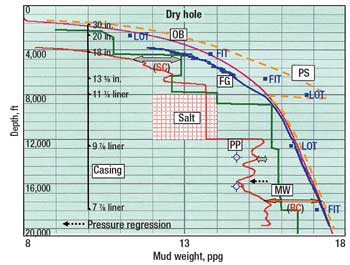
|
|
Fig. 5. The pressure plot of MC 619-1 shows a steep mud weight increase above the salt which led to the operator setting five casing strings. Modified after Shaker and Smith 2002.
|
|
Below the salt’s PS and FP retreat, mud weight shows a minor increase of 0.5 ppg from the base of salt (12,000 ft) to the well’s 21,000-ft TD. This indicates a weak transgressive pressure envelope and, consequently, failed seal compartments, i.e. absence of sealing capacity.
Therefore, the targeted subsalt reservoirs are deemed water wet. Moreover, the timing of the salt emplacement in relation to the hydrocarbon migration to the prospect might explain the failure to find hydrocarbons in this well.5 In spite of high sealing capacity in the thin sediments (6,000 ft) above the salt, the prospective section is not economical to pursue.
SALT TOES AND FOLD BELTS
The new, deeper exploration fairway is associated with the creeping salt toe at the Segsbee Escarpment.6 As a result, the lateral stress has generated compressional fold/fault structural plays in the Wilcox-equivalent sediment below the salt. The fault plane in this structural setting usually yields high sealing capacity. Perdido, Walker Ridge and the Mississippi fold belts are the new exciting and promising exploration plays. Based on the released data from these frontier wells, a geopressure model has been proposed to explain some of the trapping mechanism and drilling challenges facing the industry, Fig. 6.
|
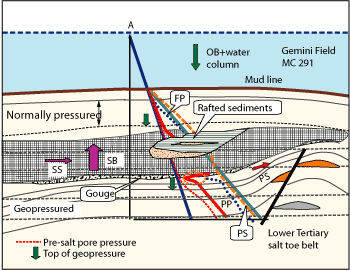
|
|
Fig. 6. This proposed geopressure model explains some of the trapping mechanism and drilling challenges facing the industry in the new frontier exploration play.
|
|
In addition to the salt buoyancy effect on the sediment, below and above the salt, rafted sediment blocks embedded in the salt mass and gouges (furrows filled with transported and crumbled sediments) at the base of the salt impact the subsurface geopressure profile. If these older rafted blocks are cased with impermeable layers, PP will show a high gradient. In the case of older sediment plowed underneath the salt toe, the shear stress will substantially reduce the PP in this thin rubble layer underneath the moving salt. Subsalt gouges represent a drilling difficulty and hazard in frontier exploration plays. In addition, the salt buoyancy will accelerate and decelerate PP above and below the salt, respectively.
Atlantis Field. This field was an exploration success that tested a prospect below the salt toe. This probably will not be the general case in the frontier Lower Tertiary fairway, where the targeted traps are located down-dip from the tip of the toe.
The geopressure plot of the discovery well Green Canyon Block 699-1 ST2 shows the relationship between PS, overburden and FP, Fig. 7. Note that the FP is close to the calculated overburden above the salt, whereas PS far exceeds the overburden and FP in the subsalt. This leads to a wide retention capacity window and the presence of a thick column of oil, especially between 17,800 ft and 18,500 ft. On the other hand, the reduction of PS in the subsalt section led to a moderate PG of about 0.61 psi/ft at about 18,400-ft depth (MDT measurements). This can be attributed to the thick salt layer above (about 7,000 ft) and the water depth of the mud line (4,495 ft). Mud weight was increased to 10.5 ppg, and an extra casing point was set in the middle of the salt due to the presence of rafted sediments within the salt body. Moreover, the possible presence of the interface salt-sediment gouge, causing a sharp drop in the PP, was responsible for the sidetrack of the original hole.
|
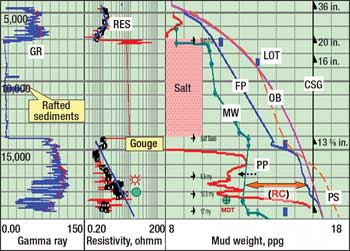
|
|
Fig. 7. The geopressure plot of the Green Canyon Block 699-1 ST2 discovery well shows that fracture pressure is close to the calculated overburden above the salt. Modified after Shaker and Smith 2002.
|
|
Several wet, sand-rich sections below the pay zone, which started at 18,500 ft to TD (19,500-ft TVD) and concurred with a mud weight increase to 12.4 ppg (overbalanced), led to thick mud cake, stuck pipe, plugback and sidetrack. BP plans to put Atlantis Field on line in 2009. Projected daily production is estimated at 250,000 bopd and 180 MMcfd.
Jack prospect. The Jack prospect is a part of the emerging Wilcox-equivalent salt toe belt at the Sigsbee Escarpment in the Gulf of Mexico deep water. It is located in the Walker Ridge Blocks 758, 759 and 678. Applying the same geopressured model to the salt toe can explain the drilling hurdles of Walker Ridge 759-1 ST 00BP00 (OCS-G-17016), which increased drilling cost to over $100 million. These challenges were:
- Lost return at the base of the salt (19,653 ft)
- Pump LCM sweep of 13.5 ppg
- Inability to stop losses
- Sidetrack
- Set casing at the salt mass (13,507 ft), possibly due to a rafted sediment block.
CONCLUSION
Exploration in deepwater mini-salt basins and frontier fold belts has yielded and is expected to produce substantial reserves, but it is also very challenging.
Subsalt prospects have many positive qualities. Salt enhances the retention capacity of the reservoirs beneath the salt and the sealing capacity in suprasalt formations. Large reserves are trapped by less-faulted structural closures as a result of salt swells in a mini-basin’s area. There is high sealing capacity of the thrust-faulted system in the fold belt fairways. Reservoirs generate high flowrates due to the high permeability of the younger sediments (Plio-Pleistocene), particularly above the salt. In addition, drilling does not require high mud density to reach objective targets.
These positive attributes can only yield substatial reserves when salt’s challenges are met. While drilling, it is common to encounter problems (kicks, shallow water flows) above the salt due the high principal stress and the pressure gradient. Several casing points may be needed to drill through this zone. Drilling hurdles, especially lost circulation, are common at the salt-sediment interface at the base of the salt, especially in the gouge zone. Drilling bypasses and sidetracks to divert borehole trajectory, to overcome troubles in this zone, sharply increase drilling costs. The moderate to weak pressure gradient and sealing capacity below the salt can be a substantial cause of seal failure and weak water drive in the production phase. There are low-permeability reservoirs in the older Wilcox-equivalent sediments (Eocene-Paleocene). Finally, there is a need to improve subsalt seismic imaging quality and accuracy. 
ACKNOWEDGEMENTS
The author is greatly indebted to Dr. Colin Sayers for his review of this manuscript and valuable technical advice.
LITERATURE CITED
1 Shaker, S. and M. Smith, “Pore pressure prediction in the challenging supra/subsalt exploration plays in deep water, GOM,” Extended abstract, AAPG Convention, 2002.
2 Berman, A. and J. Rosenfeld, “A new depositional model for the deep water Wilcox-equivalent whopper sand-Changing the paradigm,” World Oil, June, 2007.
3 Terzaghi, K., Theoretical Soil Mechanics, John Wiley and Sons, Inc., New York, 1943.
4 Shaker, S. “Geopressure compartmentalization in Keathley Canyon, deepwater of GOM,” GCAGS Transactions, 2001
5 Shaker, S. “Trapping vs. breaching seals in salt basins: A case history of Macaroni and Mt. Massive, Aluger Basin, GOM,” presented at the GCAGS Annual Convention, San Antonio, Texas, 2004.
6 Chowdhury, A. and S. Lopez-Mora, “Regional geology of deep water salt architecture, offshore GOM,” GCAGS and GCSSEPM, 2004.
|
THE AUTHOR
|
|
|
Dr. Selim S. Shaker has over 30 years of oil industry experience in Egypt, northwest Australia, Algeria, Libya, the North Sea and China. His specialty is prospect risk assessment from an exploration and drilling standpoint. Shaker’s recent work has been in the GOM’s deepwater salt mini-basins and the high-pressure/high-temperature environment of the GOM shelf. He is an active member of AAPG, AADE, SEG, HGS, GSH and GMSH. Shaker is Director and Consulting Geologist for Geopressure Analysis Services, Inc. He may be reached at email: geopressureinc@verizon.net.
|
|
|










